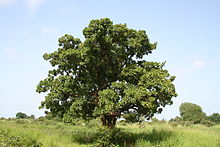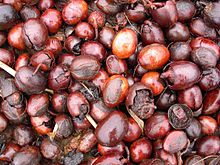| Vitellaria | |
|---|---|

| |
| Shea tree | |

| |
| Shea nuts | |
| Scientific classification | |
| Kingdom: | Plantae |
| Clade: | Tracheophytes |
| Clade: | Angiosperms |
| Clade: | Eudicots |
| Clade: | Asterids |
| Order: | Ericales |
| Family: | Sapotaceae |
| Subfamily: | Sapotoideae |
| Genus: | Vitellaria C.F.Gaertn. |
| Species: | V. paradoxa
|
| Binomial name | |
| Vitellaria paradoxa C.F.Gaertn.
| |
| Synonyms | |
|
Butyrospermum paradoxum | |
Vitellaria paradoxa (formerly Butyrospermum parkii), commonly known as shea tree, shi tree (/ˈʃiː(ə)/), or vitellaria, is a tree of the family Sapotaceae. It is the only species in the genus Vitellaria,[2] and is indigenous to Africa.
The shea fruit consists of a thin, tart, nutritious pulp that surrounds a relatively large, oil-rich seed from which shea butter is extracted. It is a deciduous tree usually 7–15 m (23–49 ft) tall, but has reached 25 m (82 ft) and a trunk diameter of 2 m (6.6 ft).
The shea tree is a traditional African food plant. It has been claimed to have potential to improve nutrition, boost food supply in the "annual hungry season",[3] foster rural development, and support sustainable land care.[4]
- ^ Cite error: The named reference
iucnwas invoked but never defined (see the help page). - ^ Vitellaria paradoxa. AgroForestry Tree Database. World Agroforestry Centre.
- ^ E.T. Masters; J.A. Yidana; P.N. Lovett. "Trade and sustainable forest management". FAO.org. Retrieved 2010-09-14.
- ^ National Research Council (2006-10-27). "Shea". Lost Crops of Africa: Volume II: Vegetables. Vol. 2. National Academies Press. ISBN 978-0-309-10333-6. Retrieved 2008-07-15.
